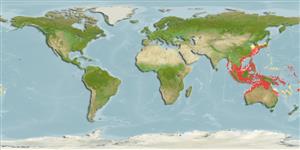Environment: milieu / climate zone / depth range / distribution range
Ecología
marino asociado a arrecife; rango de profundidad 0 - ? m (Ref. 54424), usually 0 - 20 m (Ref. 54424). Tropical; 39°N - 26°S, 91°E - 174°W (Ref. 54424)
Indo-West Pacific: South China Sea to the Mariana Islands. Reported occurrence in southern Africa could not be confirmed (Ref. 3197).
Length at first maturity / Tamaño / Peso / Age
Maturity: Lm 12.5, range 10 - 15 cm
Max length : 30.0 cm FL macho / no sexado; (Ref. 108763)
Espinas dorsales (total): 9; Radios blandos dorsales (total): 30-36; Espinas anales 3; Radios blandos anales: 25 - 30
Adults are found in the sublittoral zone and may enter semi-enclosed sea areas (Ref. 11230). In Guam, it is encountered in large numbers around fish aggregating devices, buoys anchored offshore to attract pelagic game fishes.
Life cycle and mating behavior
Madurez | Reproducción | Puesta | Huevos | Fecundidad | Larva
Myers, R.F., 1991. Micronesian reef fishes. Second Ed. Coral Graphics, Barrigada, Guam. 298 p. (Ref. 1602)
IUCN Red List Status (Ref. 130435)
Threat to humans
Harmless
Human uses
Pesquerías: muy comercial
Herramientas
Special reports
Download XML
Fuentes de Internet
Estimates based on models
Preferred temperature (Ref.
123201): 22.7 - 29, mean 28 °C (based on 892 cells).
Phylogenetic diversity index (Ref.
82804): PD
50 = 0.5010 [Uniqueness, from 0.5 = low to 2.0 = high].
Bayesian length-weight: a=0.01148 (0.00955 - 0.01380), b=2.96 (2.93 - 2.99), in cm total length, based on LWR estimates for this species (Ref.
93245).
Nivel trófico (Ref.
69278): 3.4 ±0.45 se; based on food items.
Generation time: 1.1 (1.0 - 1.4) years. Estimated as median ln(3)/K based on 20
growth studies.
Resiliencia (Ref.
120179): Alto, población duplicada en un tiempo mínimo inferior a 15 meses (K=0.5-1.3; tmax=9).
Fishing Vulnerability (Ref.
59153): Low vulnerability (23 of 100).
Climate Vulnerability (Ref.
125649): Moderate vulnerability (38 of 100).
Nutrients (Ref.
124155): Calcium = 300 [102, 710] mg/100g; Iron = 3.11 [1.18, 6.59] mg/100g; Protein = 20.4 [19.1, 21.7] %; Omega3 = 0.234 [0.122, 0.435] g/100g; Selenium = 84.3 [30.9, 199.6] μg/100g; VitaminA = 41.6 [13.6, 143.1] μg/100g; Zinc = 1.4 [0.8, 2.2] mg/100g (wet weight);
